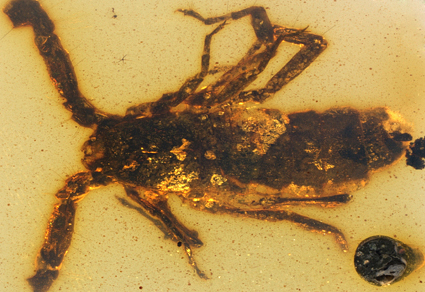Abstract
Among the scarce Mesozoic fossils, protoischnurid scorpions (Arachnida: Scorpiones: Protoischnuridae) represent a Cretaceous extinct group. In this study, we present the description of a new protoischnurid fossil, assigned to the genus Cretaceoushormiops Lourenço, from mid-Cretaceous Burmese amber. Distinguished by a median suture and a comparatively short anterior margin in its carapace, the new specimen differs from all other species within Cretaceoushormiops. Our discovery sheds further light on the high diversity of mid-Cretaceous scorpions.
References
- de Carvalho, M.G.P., Maisey, J.G., Mendes, I.D. & de Souza Carvalho, I. (2023) Micro-tomographic analysis of a scorpion fossil from the Aptian Crato Formation of North-Eastern Brazil. Cretaceous Research, 147, 105454. https://doi.org/10.1016/j.cretres.2022.105454.
- Fu, Y.Z., Li, Y.D., Su, Y.T., Cai, C.Y. & Huang, D.Y. (2021) Application of confocal laser scanning microscopy to the studyof amber bioinclusions. Palaeoentomology, 4 (3), 266–278. https://doi.org/10.11646/palaeoentomology.4.3.14
- Loria, S.F. & Prendini, L. (2014) Homology of the lateral eyes of Scorpiones: A six-ocellus model. PLoSOne, 9, e112913. https://doi.org/10.1371/journal.pone.0112913
- Lourenço, W.R. (2018) A new remarkable scorpion genus and species from Cretaceous Burmese amber (Scorpiones: Protoischnuridae). Arachnida—Rivista Aracnologica Italiana, 13, 11–21.
- Lourenço, W.R. (2023) Scorpions trapped in amber: a remarkable window on their evolution over time from the Mesozoic period to present days. Journal of Venomous Animals and Toxins including Tropical Diseases, 29, e20230040. https://doi.org/10.1590/1678-9199-JVATITD-2023-0040
- Lourenço, W.R. & Velten, J. (2022) A second new species for the genus Cretaceoushormiops Lourenço, 2018 from Cretaceous Burmite (Scorpiones: Protoischnuridae). Faunitaxys, 10 (43), 1–5. https://doi.org/10.57800/faunitaxys-10(43)
- Lourenço, W.R. & Velten, J. (2023a) Confirmation of the validity of the genus Cretaceousbuthus Lourenço, 2022 and description of a new species from Burmite (Scorpiones: Buthoidea: Buthidae). Faunitaxys, 11 (35), 1–6. https://doi.org/10.57800/faunitaxys-11(35)
- Lourenço, W.R. & Velten, J. (2023b) A second species of Archaeoscorpiops Lourenço, 2015 from Cretaceous Burmese amber (Scorpiones: Palaeoeuscorpiidae). Faunitaxys, 11 (57), 1–4. https://doi.org/10.57800/faunitaxys-11(57)
- Ross, A.J. (2019) Burmese (Myanmar) amber checklist and bibliography, 2018. Palaeoentomology, 2 (1), 22–84. https://doi.org/10.11646/palaeoentomology.2.1.5
- Ross, A.J. (2020) Supplement to the Burmese (Myanmar) amber checklist and bibliography, 2019. Palaeoentomology, 3 (1), 103–118. https://doi.org/10.11646/palaeoentomology.3.1.14
- Ross, A.J. (2021) Supplement to the Burmese (Myanmar) amber checklist and bibliography, 2020. Palaeoentomology, 4 (1), 57–76. https://doi.org/10.11646/palaeoentomology.4.1.11
- Ross, A.J. (2022) Supplement to the Burmese (Myanmar) amber checklist and bibliography, 2021. Palaeoentomology, 5 (1), 27–45. https://doi.org/10.11646/palaeoentomology.5.1.4
- Ross, A.J. (2023) Supplement to the Burmese (Myanmar) amber checklist and bibliography, 2022. Palaeoentomology, 6 (1), 22–40. https://doi.org/10.11646/palaeoentomology.6.1.6
- Stahnke, H.L. (1970) Scorpion Nomenclature and Mensuration. Entomological News, 81, 297–316.
- Soleglad, M.E. & Fet, V. (2003) High-level systematics and phylogeny of the extant scorpions (Scorpiones: Orthosterni). Euscorpius, 11, 1–175.
- Vachon, M. (1963) De l’utilité, en systématique, d’une nomenclature des dents de chelicères chez les Scorpions. Bulletin Du Muséum National D’histoire Naturelle, Paris, 35, 161–166.
- Vachon, M. (1974) Étude des caractères utilisés pour classe les familles et les genres de Scorpiones (Arachnides). 1. La trichobothriotaxie en Arachnologie. Sigles trichobothriaux et types de trichobothriotaxie chez les scorpions. Bulletin Du Muséum National D’histoire Naturalle Paris, Zoologie, 140, 857–958.
- Xuan, Q., Cai, C.Y., Zhang, Z.J. & Huang, D.Y. (2023a) A new species of Cretaceoushormiops from the mid-Cretaceous amber of northern Myanmar (Arachnida: Scorpiones: Protoischnuridae). PalZ, 673, 1–11. https://doi.org/10.1007/s12542-023-00673-7
- Xuan, Q., Cai, C.Y. & Huang, D.Y. (2023b) Revision of palaeoburmesebuthid scorpions in mid-Cretaceous amber from northern Myanmar (Scorpiones: Buthoidea). Palaeoentomology, 6 (1), 64–101. https://doi.org/10.11646/palaeoentomology.6.1.10


